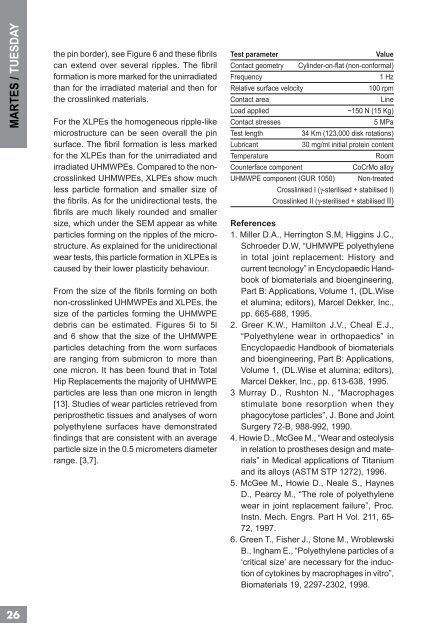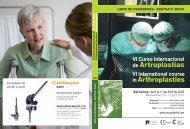cadera / hip - Active Congress.......
cadera / hip - Active Congress.......
cadera / hip - Active Congress.......
Create successful ePaper yourself
Turn your PDF publications into a flip-book with our unique Google optimized e-Paper software.
MARTES / TUESDAY<br />
26<br />
the pin border), see Figure 6 and these fi brils<br />
can extend over several ripples. The fi bril<br />
formation is more marked for the unirradiated<br />
than for the irradiated material and then for<br />
the crosslinked materials.<br />
For the XLPEs the homogeneous ripple-like<br />
microstructure can be seen overall the pin<br />
surface. The fi bril formation is less marked<br />
for the XLPEs than for the unirradiated and<br />
irradiated UHMWPEs. Compared to the noncrosslinked<br />
UHMWPEs, XLPEs show much<br />
less particle formation and smaller size of<br />
the fi brils. As for the unidirectional tests, the<br />
fi brils are much likely rounded and smaller<br />
size, which under the SEM appear as white<br />
particles forming on the ripples of the microstructure.<br />
As explained for the unidirectional<br />
wear tests, this particle formation in XLPEs is<br />
caused by their lower plasticity behaviour.<br />
From the size of the fi brils forming on both<br />
non-crosslinked UHMWPEs and XLPEs, the<br />
size of the particles forming the UHMWPE<br />
debris can be estimated. Figures 5i to 5l<br />
and 6 show that the size of the UHMWPE<br />
particles detaching from the worn surfaces<br />
are ranging from submicron to more than<br />
one micron. It has been found that in Total<br />
Hip Replacements the majority of UHMWPE<br />
particles are less than one micron in length<br />
[13]. Studies of wear particles retrieved from<br />
periprosthetic tissues and analyses of worn<br />
polyethylene surfaces have demonstrated<br />
fi ndings that are consistent with an average<br />
particle size in the 0.5 micrometers diameter<br />
range. [3,7].<br />
Test parameter Value<br />
Contact geometry Cylinder-on-fl at (non-conformal)<br />
Frequency 1 Hz<br />
Relative surface velocity 100 rpm<br />
Contact area Line<br />
Load applied ~150 N (15 Kg)<br />
Contact stresses 5 MPa<br />
Test length 34 Km (123,000 disk rotations)<br />
Lubricant 30 mg/ml initial protein content<br />
Temperature Room<br />
Counterface component CoCrMo alloy<br />
UHMWPE component (GUR 1050) Non-treated<br />
Crosslinked I (γ-sterilised + stabilised I)<br />
Crosslinked II (γ-sterilised + stabilised II)<br />
References<br />
1. Miller D.A., Herrington S.M, Higgins J.C.,<br />
Schroeder D.W, “UHMWPE polyethylene<br />
in total joint replacement: History and<br />
current tecnology” in Encyclopaedic Handbook<br />
of biomaterials and bioengineering,<br />
Part B: Applications, Volume 1, (DL.Wise<br />
et alumina; editors), Marcel Dekker, Inc.,<br />
pp. 665-688, 1995.<br />
2. Greer K.W., Hamilton J.V., Cheal E.J.,<br />
“Polyethylene wear in orthopaedics” in<br />
Encyclopaedic Handbook of biomaterials<br />
and bioengineering, Part B: Applications,<br />
Volume 1, (DL.Wise et alumina; editors),<br />
Marcel Dekker, Inc., pp. 613-638, 1995.<br />
3 Murray D., Rushton N., “Macrophages<br />
stimulate bone resorption when they<br />
phagocytose particles”, J. Bone and Joint<br />
Surgery 72-B, 988-992, 1990.<br />
4. Howie D., McGee M., “Wear and osteolysis<br />
in relation to prostheses design and materials”<br />
in Medical applications of Titanium<br />
and its alloys (ASTM STP 1272), 1996.<br />
5. McGee M., Howie D., Neale S., Haynes<br />
D., Pearcy M., “The role of polyethylene<br />
wear in joint replacement failure”, Proc.<br />
Instn. Mech. Engrs. Part H Vol. 211, 65-<br />
72, 1997.<br />
6. Green T., Fisher J., Stone M., Wroblewski<br />
B., Ingham E., “Polyethylene particles of a<br />
‘critical size’ are necessary for the induction<br />
of cytokines by macrophages in vitro”,<br />
Biomaterials 19, 2297-2302, 1998.





